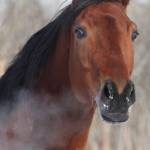Choke Points in the Horse’s Respiratory System

In order for a horse to be able to perform at maximal ability, he must be able to take in large amounts of oxygen. Anything that impairs this ability is a choke point that limits performance.
The oxygen consumed by working muscles originates from inhaled air. Air contains about 21% oxygen, and the horse must take in air at a rate that is high enough to supply the body with as much as 90 liters of oxygen per minute. The amount of air that the horse can inspire is a product of its respiratory rate multiplied by tidal volume. Respiratory rate during the gallop is linked mechanically to stride frequency so the horse takes a breath with every step. Respiratory rate can reach in excess of 220 breaths per minute and tidal volume can be as high as 12 liters per breath. Thus, the horse inspires and expires at a rate of over three times per second. During this extremely short period, oxygen must be moved from the air in the lung into the blood.
There are several potential problems with the horse’s respiratory system. First, many horses have a partial paralysis of the muscles in the larynx which reduces the size of the opening of the windpipe. In its advanced stages this problem is called roaring because of the noise the horse makes during exercise. Even a small reduction in the opening of the windpipe can greatly reduce the amount of air that reaches the lungs. Fortunately, surgical procedures can often greatly improve the performance of a horse afflicted with this disease.
Another potential problem is damage to the lung. One problem is called heaves, which is a hyperallergenic response of the respiratory system similar to that seen in human asthma. Affected horses may cough, develop a nasal discharge, and have exercise intolerance. Respiratory rate is increased, and lung elasticity is diminished.
The most important aspect of treatment for “heavey” horses is recognition of its cause: exposure to dust, mold spores, and respiratory irritants such as ammonia. Horses affected with heaves are best kept outside and managed in pastures rather than in stalls. When this is not possible, horses should be bedded on low-dust bedding such as wood shavings, shredded paper, or peat moss.
Another common problem in performance horses is exercise-induced pulmonary hemorrhage (EIPH) or “bleeding.” Horses with EIPH bleed from the lungs during intense exercise. The cause of bleeding is still unclear. The use of the diuretic furosemide (Lasix/Salix) has been a common treatment.








